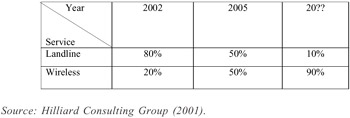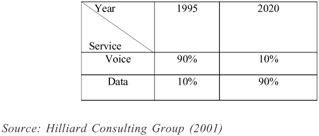These Significant Trends Favor Wireless over Land Lines
|
What this high-level analysis indicates is that the world of telecom service providers and telecom equipment manufacturers is going to change dramatically. Clearly, defining where we are today is not so difficult, and seeing the future also is not so difficult. The hard part is filling in "The Gap" with discrete time lines of where we have to be, by when, based on an understanding of the states of technology and market drivers. Such an analysis may be performed for any industry with an understanding that the model needs to be continually updated. But one thing is abundantly clear—the telecommunications world is moving to broadband wireless.
This trend may be seen by examining the projected relative mix shifts and market penetration levels taking place in the market today (Tables 3 and 4, Figure 3).
|
|
|
|

Figure 3: Hanging up on the Bells—Technology Elasticity and Service Substitution
As can be seen from these tables and figure, there is projected to be a significant move from land-line to wireless, and voice to data communications as a percent of the overall market. Clearly, voice communications is not going to become curtailed; rather, information in the tables indicates that data will grow dramatically in proportion to voice and thus constitute a larger percentage of the mix. However, wireless will make significant inroads into land-line communications, and this trend has already begun, as seen in Figure 3, from Solomon Smith Barney. Moreover, if the Regional Bell Operating Companies (RBOCs) are successful in having the Federal Communications Commission (FCC) roll back the competitive gains made under the 1996 Telecom Act (UNE-P and TELRIC), the effect of which was to foster more competitive prices, wireless providers should be in an excellent position to offer a wider array of services at very competitive prices relative to land-line solutions, as the RBOCs will likely increase rates once certain competitive elements are removed. So, just as the "Digital One Rate" wireless calling plans first began to penetrate the long-distance land-line market, they too are now making inroads in the local land-line markets, and this trend is likely to continue. Further buttressing this trend is the designation of Western Wireless to "Eligible Carrier Status" in a number of western states, thereby making Western Wireless able to qualify for "Universal Service Funds" for its wireless network services. [4]
[4]http://www.wwireless.com.
|
EAN: 2147483647
Pages: 139

